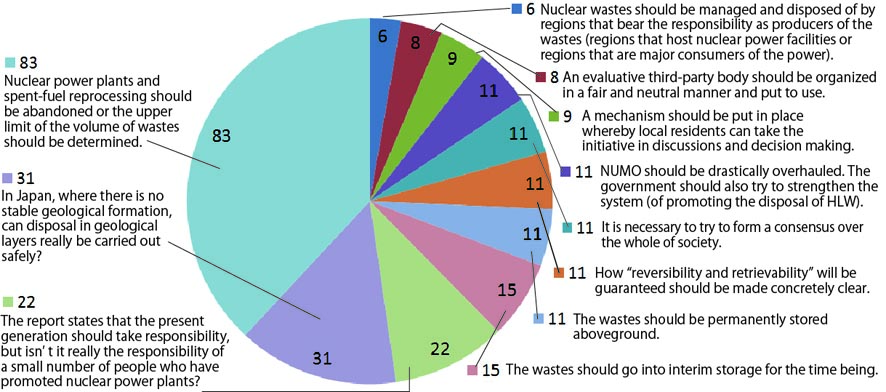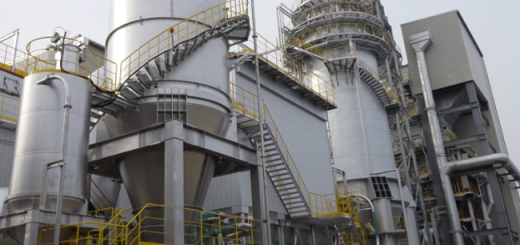Summary of Discussions in the Government Radioactive Wastes Working Group- Many unresolved problems remain Nuke Info Tokyo No. 161
The Japanese government’s Radioactive Wastes Subcommittee, reestablished in May 2013, comprised of different members from those in the subcommittee under the Electricity and Gas Industry Committee of the Advisory Committee for Natural Resources and Energy, Ministry of Economy, Trade and Industry. The subcommittee has been renamed the Radioactive Wastes Working Group (“Radioactive Wastes WG”) from the time it met for the third time on July 5, 2013, and has been meeting regularly since then. On May 23, 2014, up to which time 13 meetings had been held, the WG publicized an interim report1) of its discussions.
The Japanese government plans to bury high-level radioactive wastes deep underground, deeper than 300 meters from the surface, as the final disposal method. Since 2002, the Nuclear Waste Management Organization of Japan (NUMO), the main body supervising the project, has been openly soliciting applications for host locations for the disposal site from municipalities nationwide.
However, all the municipalities that expressed interest in applying were confronted with opposition from local residents and forced to desist from submitting the application. Thus, to date, no application has been delivered. As a result, the government has accelerated moves to enable the designation of candidate municipalities from the government side and to request them to accept onsite research for the determination of suitability as the disposal site. The Radioactive Wastes WG was established as part of this move.
Contents of the Interim Report
The Interim Report of the Radioactive Wastes WG consists of six chapters in 32 pages of text. In the “Introduction,” the report states that in order to carry out the project the WG intends to review the conventional basic policy concerning high-level nuclear wastes and the final disposal project from the very basics. Chapter 2 discusses current conditions and problems; Chapter 3 describes efforts the present generation should make; Chapter 4 gives measures for improving these efforts; Chapter 5 discusses improvements in the disposal promotion organization. The following consists of summaries of the third and following chapters of the report.
The present generation is required to make substantial efforts to realize the final disposal of radioactive wastes. However, proceeding with the efforts as if the project was a “done deal” is not sufficiently supported by society (Section3-1). To gain social support, it is essential to establish a system that, in consideration of technical uncertainty, will guarantee reversibility and retrievability, and will enable current and future generations to review earlier decisions concerning final disposal (3-2). As a final disposal method, geological disposal is the most promising, but alternative methods will also be studied (3-3). Social consensus should be developed through the evaluation of disposal technology improvement and alternative technologies (3-4). For consensus development, people from a wide range of social standings should have earnest in-depth discussions. Through the discussions, an awareness that the final disposal of radioactive wastes is an unavoidable issue should be developed, along with an understanding of ideas regarding the nature of nuclear power policies (3-5).
The government, for example, should indicate a location that is considered more scientifically suitable for final disposal than other locations, and explain the geological environmental characteristics of the location from a scientific point of view, thus gaining an understanding by local residents regarding the selection of the location as the final disposal site (4-1). A system for developing a consensus should be introduced into the location, and local residents of different social standings should participate in this (4-2). The government should plan measures that will support the location that has accepted the construction of the disposal site (4-3).
As measures to improve the conventional system for promoting the siting of the final disposal site, NUMO, which will implement the disposal project, should be fundamentally reformed (5-1), and third-party evaluation, essential to ensure the reliability of the disposal project (5-2), should be introduced.
The report, with reference to international agreements, clearly states that the disposal of radioactive wastes domestically is a fundamental policy, thus nullifying the possibility of the disposal of radioactive wastes overseas, where more geologically stable locations may be available.
Public opinions for this proposed Interim Report were solicited for one month, and many critical opinions were delivered. Of 121 opinions received, 83 indicated that before the disposal of radioactive wastes is discussed, nuclear power plants and spent-fuel reprocessing should be abandoned or the upper limit of the volume of wastes should be determined. Many doubted the safety of geological disposal (31 opinions). Other opinions included: “The small number of people who have promoted nuclear power plants should take primary responsibility for the wastes instead of the facile insistence on the responsibility of the entire generation” (22); “The wastes should go into interim storage for the time being” (15); and “The wastes should be permanently stored aboveground” (11).
 |
| Summary of public opinion for the interim report of the Radioactive Wastes Working Group |
Unresolved problems
The Interim Report includes many unresolved problems.This author had assumed that the Geological Disposal Technology Working Group (“Technology WG”), newly established in October last year, would discuss any locations that might be scientifically promising for hosting a radioactive wastes disposal site. However, the Technology WG ended up naming no prospective locations. At the meetings of the Technology WG, NUMO repeatedly asserted that it would evaluate prospective locations from all angles, in consideration of engineering measures, even if some conditions were unsatisfied in terms of geological environment, water-quality environment, or any other matters.
This indicates NUMO’s policy in soliciting applications from municipalities for hosting a final disposal site; the policy is based on the organization’s idea that if engineering measures are taken appropriately (if artificial barriers are provided), most locations within Japan are geologically suitable (wastes can be buried in 70% of the total area of Japan). However, if such is the case, no specific municipalities can be selected for the government to request acceptance of the construction of a disposal site. For the government to request municipalities to host the site, more detailed discussions on the selection of promising locations are indispensible.
Discussion on how to guarantee local resident participation in the selection process and ensure the revocability of earlier decisions has also been insufficient. In-depth discussion regarding by whom and through what process the acceptance of literature research will be determined has not been conducted, nor has the procedure for revoking decisions been discussed. These steps have not been specified such that they are organized into an established system.
To carry out the geological disposal project, it is critical to ensure that the activities of the government and NUMO are fair and that information released is objective. If the fairness of the activities and the objectivity of the information are verified by a third party, the project may be able to gain trust from society. People have been deceived by the government and businesses many times in the past, and a third-party panel would have a critical role to play.
Nuclear Waste WG meetings discussed the cases of France and Sweden, but the character and status of these are not precisely applicable to Japan. It is necessary to prepare a system with reference to the cases of countries other than these.
The Interim Report suggests that the Japan Atomic Energy Commission (JAEC) can play the role of the third-party panel. However, if the JAEC assumes this role, public criticism that interested parties are simply attempting to promote their own preferences will be unavoidable. A reliable organization should be established, and it should be administered fairly and transparently. In achieving this end, many issues, such as who should participate in the panel and who should share the costs, remain undiscussed. The discussions in the report mention only the necessity of solving these issues.
If the project is promoted while participation by local residents and the revocability of decisions remain unguaranteed, a scientifically unsuitable location may be selected in the political context and the placement of the site in the location eventually determined.
At the same time, subsidies may be sent to the location and various reasons for promotion of the site invented as soon as the document study begins. In such a case, the release of radioactive material from the buried wastes into the living environment might start to occur earlier than expected.
On the condition that no further radioactive wastes will be produced, all possible efforts should be made to minimize the influence of already existing wastes on future generations. For this reason, the author believes that discussion on this issue should be further prolonged.
(Hideyuki Ban, Co-director of CNIC)
1) www.meti.go.jp/committee/sougouenergy/denryoku_gas/genshiryoku/houshasei_haikibutsu_wg/report_001.pdf (in Japanese)

